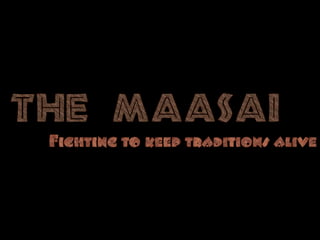Maasai History Project Africa
•Transferir como PPS, PDF•
0 gostou•3,088 visualizações
An informational timeline about the effects of European colonization on the Maasai culture. (written by E. N. Nevius)
Denunciar
Compartilhar
Denunciar
Compartilhar

Recomendados
Recomendados
Mais conteúdo relacionado
Destaque
Destaque (20)
Africa Geographic Photographer of the Year 2016: Featured Entries (2)

Africa Geographic Photographer of the Year 2016: Featured Entries (2)
New York Yankees Summer Reading Kick-off at The New York Public Library

New York Yankees Summer Reading Kick-off at The New York Public Library
East Africa Partnership Kenya Medical Relief Project November 2008

East Africa Partnership Kenya Medical Relief Project November 2008
A presentation on Enhancing Pastoralist Education Through ICT at the Humanita...

A presentation on Enhancing Pastoralist Education Through ICT at the Humanita...
Semelhante a Maasai History Project Africa
Semelhante a Maasai History Project Africa (20)
Political revolution in the northern and southern interior

Political revolution in the northern and southern interior
2006. Beautiful Beasts And Brave Warriors The Longevity Of A Maasai Stereo...

2006. Beautiful Beasts And Brave Warriors The Longevity Of A Maasai Stereo...
Último
Último (20)
Asian American Pacific Islander Month DDSD 2024.pptx

Asian American Pacific Islander Month DDSD 2024.pptx
Energy Resources. ( B. Pharmacy, 1st Year, Sem-II) Natural Resources

Energy Resources. ( B. Pharmacy, 1st Year, Sem-II) Natural Resources
General Principles of Intellectual Property: Concepts of Intellectual Proper...

General Principles of Intellectual Property: Concepts of Intellectual Proper...
Measures of Central Tendency: Mean, Median and Mode

Measures of Central Tendency: Mean, Median and Mode
Mixin Classes in Odoo 17 How to Extend Models Using Mixin Classes

Mixin Classes in Odoo 17 How to Extend Models Using Mixin Classes
Python Notes for mca i year students osmania university.docx

Python Notes for mca i year students osmania university.docx
Unit-IV; Professional Sales Representative (PSR).pptx

Unit-IV; Professional Sales Representative (PSR).pptx
This PowerPoint helps students to consider the concept of infinity.

This PowerPoint helps students to consider the concept of infinity.
ICT Role in 21st Century Education & its Challenges.pptx

ICT Role in 21st Century Education & its Challenges.pptx
Presentation by Andreas Schleicher Tackling the School Absenteeism Crisis 30 ...

Presentation by Andreas Schleicher Tackling the School Absenteeism Crisis 30 ...
Beyond the EU: DORA and NIS 2 Directive's Global Impact

Beyond the EU: DORA and NIS 2 Directive's Global Impact
Maasai History Project Africa
- 2. The Maasai were once a great and powerful people. They had dominated much of eastern Africa and were greatly respected and feared by all surrounding tribes. They were an army power, having a reputation for brutal warriors and warlike tendencies. … So what happened?
- 3. In around the sixteenth and seventeenth centuries, the Portuguese headed down into the Nile River valley, of where, at that point, was home to the Maasai. It’s believed that around this time is when the Maasai left the Nile River valley and relocated themselves farther south into the Great Rift Valley and into Tanzania.
- 4. For a while after this, the Maasai were mostly not bothered by the Europeans (assuming they hadn’t yet reached that part of Africa). Things, however, began to change drastically for the Maasai around the mid-nineteenth century when European missionaries and explorers made their way into the Great Rift Valley.
- 5. The missionaries made strong attempts to convert the tribe and make the Maasai stop doing some of their traditional practices. Ultimately, they were trying to “civilize” the Maasai, but in all these years, the Maasai have proven the Europeans’ efforts to be futile, as the Maasai still stick very close to their ancient traditions.
- 6. The explorers on the other hand couldn’t have cared less about the tribe. They were more concerned about expanding their trade routes and, well, exploring. This, however, is where the Maasai culture took the hardest blows. Much of their land was taken away in the late nineteenth century when a railway was built that cut right through the middle of Maasai lands. That was only the beginning of the land loss.
- 7. In the end of the nineteenth century, a plague of drought, famine, and smallpox (brought by the Europeans) swept through the Maasai during which time rinderpeste had also wiped out a good portion of the livestock. With the Maasai in such a weak state, the surrounding tribes took advantage of the opportunity to take over some of the Maasai’s land. In efforts to control this and stop the inter-tribal warfare, the government, established by the Europeans, set border lines, guarded with armed forces. The lines were not to be crossed by any one tribe, and to a nomadic culture such as the Maasai, this didn’t fair well at all.
- 8. More land was taken in the early twentieth century when treaties (though not positive about how accurately “treaty-like” they were) were formed between the Maasai and British in the years of 1904, ’11, and ’12. In these years, the Maasai had lost some of their most valued lands for grazing to the British for colonizing.
- 9. Additional land was taken from the Maasai throughout much of the twentieth century for nature preserves and parks. Much of the resources that the Maasai rely on for survival were cut short because of this. They are being forced to drop some of their strong traditional beliefs to be able to survive. Since they don’t have enough grazing area to rely on only livestock for food, they now have to trade with neighboring tribes for agricultural foods. They have also began to sell livestock to buy things like beads, crops, and other livestock. The Maasai culture, however, is anything but lost. It’s in fact thriving quite well but has merely been adapted to the changes of the surrounding world. The Maasai may have lost a lot, but they definitely didn’t lose their driving spirit.
